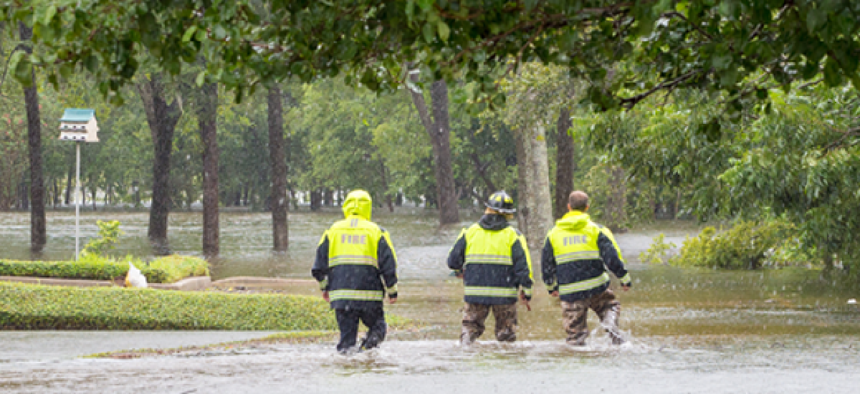Technology will drive 2020 hurricane readiness and response

As emergency response agencies prepare for hurricanes against the backdrop of COVID-19, they must train staff, validate processes and policies and test and update technology to better inform response and mitigate health risks to responders.
The 2020 hurricane season officially began a few weeks ago, but it was preceded by two named storms and dire predictions from many experts for a particularly active year of storms. More daunting still, the 2020 season overlaps the first wave of the global COVID-19 pandemic, complicating hurricane preparedness and prompting the Federal Emergency Management Agency to urge preparedness and issue operational guidance for adapting response and recovery plans to the pandemic. A mix of tried and true and innovative, new technologies will play a key role in ensuring local, state, tribal and federal agencies are ready, responsive and able to recover.
Interoperable communications for cross-functional collaboration
Effective emergency response hinges first and foremost on reliable and interoperable voice communications. The use of secure Project 25 land mobile radio networks and devices has long been the standard for mission-critical voice communications, allowing collaboration across disparate agencies and law enforcement, firefighter, EMS and other first responders involved in the aftermath of a hurricane. The radio networks generally remain operational when cellular networks do not, allowing the coordination of evacuations, search, rescue and recovery operations and other vital activities in impacted areas.
The complexities of the pandemic make it more important than ever that response agencies inventory radios and communications devices to account for surge use, perform preventative maintenance checks and refuel generators that keep communications networks and 911 call centers operational during and after a hurricane. They should also preposition recovery assets, including equipment and personnel, to minimize the movement of resources in the midst of a storm and allow personnel to focus on disaster response.
Cloud-based technologies for mission continuity
To help prevent and mitigate the spread of COVID-19, the medical community has emphasized that individuals must social distance. This fact doesn’t change during a hurricane, and that’s where the cloud comes in. While there will always be a need to deploy some individuals to provide on-site emergency support, the cloud enables agencies to minimize the human footprint by allowing many non-essential employees to support recovery efforts from remote locations. This includes supervisors who can monitor situations remotely.
The pandemic has hastened agencies' migration to cloud-based computer-aided dispatch or backup CAD systems for mission continuity and anytime, anywhere connectivity. The move to the cloud delivers maximum reliability and resilience and is a key consideration in any disaster planning scenario in which staff may be dislocated for an extended period of time.
Command center software for streamlined intelligence
Software that supports public safety ecosystems helps streamline and mobilize the flow of intelligence during a disaster, when saving seconds can save lives. Key features of “command center” software can be deployed remotely via the cloud or on-premise. For example, the Department of Emergency Communications in Alexandria, Va., recently enabled 911 call takers to work from remote centers and even from home in response to the pandemic using a solution that is essentially a “call center in a box.” Several other agencies are taking the same approach as they prepare for a potential second wave of COVID-19 or other emergencies. The City of Alexandria is now getting calls from other agencies who want to make remote work a component of their disaster planning and resiliency.
Preparation that provides remote technology and training will serve these agencies well should storms increase in intensity and frequency, even in areas that have historically been less vulnerable.
Video and analytics for situational awareness
Severe storms with high winds have exposed flaws in wireless mobile broadband networks, but to the extent that they remain operational, they can carry high-speed data, location information, images and video to users in the field for enhanced situational awareness. Fixed video cameras mounted on buildings, street posts and businesses along with smart analytics can alert personnel to threats and provide critical information, such as the levels of rising water. These technologies can also deliver the data needed to properly evaluate a situation for more effective allocation of people and resources, assess damage and track and locate valuable debris. Drones can also be deployed to quickly assess impacts to flooded, dangerous or remote areas to bring greater intelligence to emergency response.
The region that surrounds Offutt Air Force Base in Bellevue, Neb., for example, is prone to tornadoes and flooding. The base uses fixed security cameras and software to record and analyze aircraft landings and take-offs, but also for increased situational awareness during emergencies and natural disasters. In 2019, Offutt experienced mass flooding at the base due to record-setting snowfall, and water levels rose so fast and so high that many base monitoring systems were shut down. However, officials were able to track water levels remotely from cameras on the air traffic control tower and share real-time and recorded video with base security teams.
Emergency managers at all levels of government are grappling with hurricane readiness and response against the backdrop of COVID-19, preparing to keep their people and communities safe from overlapping threats. Now is the time to have people trained, processes and policies validated and technology tested and updated so they can save vital time, accurately inform response and mitigate health risks to responders in the moments that matter most.
NEXT STORY: Virginia consolidates COVID response data





